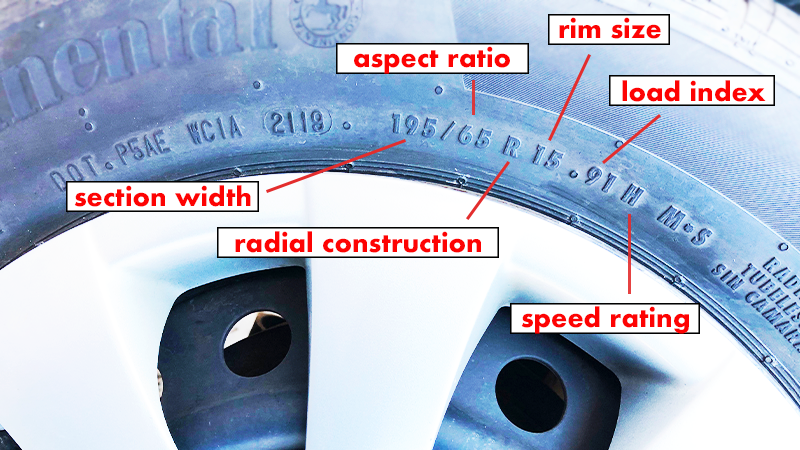Your tires can tell you a lot — if you know how to read what they have to say.
Many years ago, the tire industry established a set of standards for the information that's embossed on the sidewall of tires. This alphanumeric code denotes standardized tire sizes, inflation, manufacture date and other information, so let's break it down.
Source | Lisa Kowite
A typical tire size might read:
P 205/65 R 15 92 H
Here's what that means.
P — This denotes a Passenger or P-metric tire built to U.S. standards. Here are other possible prefixes:
- LT is for a light truck.
- ST is for a special trailer.
- T is for temporary, usually indicating a spare tire.
- European-standard tires won't have a prefix letter at all.
205 — This is the section width of the tread, from sidewall to sidewall. In this case, the tire's section width is 205 millimeters.
65 — This two-digit number is the aspect ratio. Aspect is the height of the sidewall expressed as a percentage of the section width; in this case, the sidewall's height is 65 percent the width of the section width.
R — This indicates your tire's design, which in this case is radial. Radial is the most common tire design on the market today, but you might see one of these instead:
- B is for bias belt, which is rarely found in passenger or light tires in the U.S. today.
- D is for diagonal.
- If there is no letter marking, then you likely have a cross ply tire.
15 — Fits on a 15-inch rim.
92 — This is your tire's load index. Load index is a code that indicates how many pounds a tire can carry at a given inflation level. In this instance, a load index of 92 would mean that tire is capable of carrying 1,389 pounds at 36 psi inflation.
H — This indicates the speed rating. Speed rating is the highest speed a tire can safely handle, determined through lab testing. In this case, an H-rated tire is good for speeds up to 130 mph.
| Code | Maximum Speed (mph) |
| Q | 100 |
| S | 112 |
| T | 118 |
| U | 124 |
| H | 130 |
| V | 149 |
| W | 168 |
| Y | 186 |
| Z | More than 149 |
There's a lot more info on a tire, though...
You will also notice a separate code, mandated by the DOT. Let's say that code reads as follows:
DOT CC9L XYZ1016
DOT is, well, Department of Transportation.
CC — A plant code that indicates the tire manufacturer and plant location
9L — Manufacturer-specific code that expresses tire size
XYZ — This is a code for brand characteristics. Like with the 9L symbol, it's intended for internal use between the manufacturer and distributor.
1016 — this is the date of manufacture. In this instance, 1016 indicates the 10th week of 2016.
Other information might include...
TREADWEAR 520 TRACTION A TEMPERATURE A
The treadwear grade is on a scale compared to other tires, and the 520 figure places this tire on a scale. Treadwear grades were designed by the National Highway Safety Administration and take heat resistance, rolling resistance, and other factors into account, and a tire with a treadwear grade of 200 is rated with twice the tread life of one with a 100 grade. Although this is part of the Uniform Tire Quality Grade, you're better off referring to your tires' actual treadwear warranty.
Traction grade can be expressed as C, B, A, or AA, with C being worst. An A-rated tire would have very good wet-weather traction and stopping power, but not superior. The temperature rating indicates the tire's ability to dissipate heat, and can be expressed as A, B, or C (A being best).
Finally, there's load capacity and maximum inflation level:
MAX LOAD 635 KG (1,400 lbs) AT 300 kPa (44 psi) MAX PRESS.
This one is fairly self-explanatory. This tire can support a maximum load of 1,400 pounds, at a hot-air pressure of 44 psi. Remember that 44 psi is the top limit of what this tire's air pressure should be, and only when the tire is hot. This isn't necessarily the inflation level you should maintain on your tires — check your owner's manual for manufacturer's recommendations. It can also sometimes be found in the glove box or driver-side doorjamb.
And now you know how to read tire codes!









